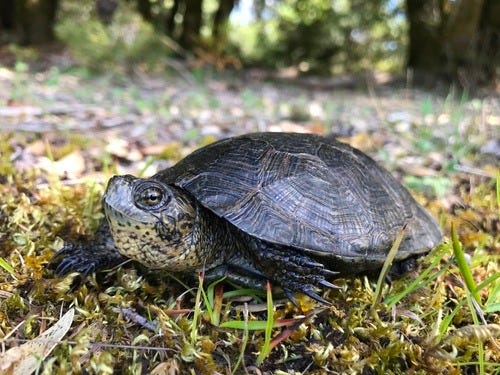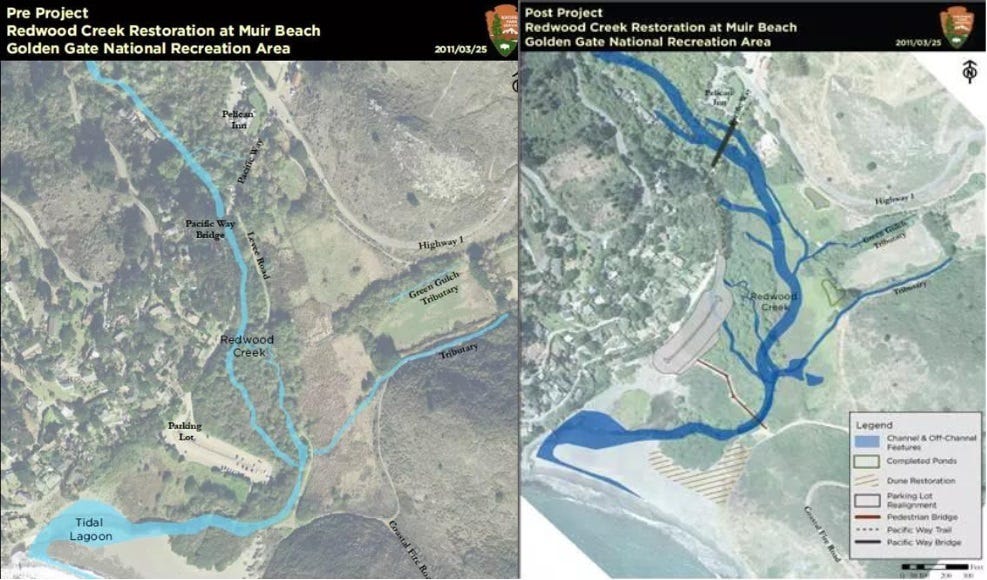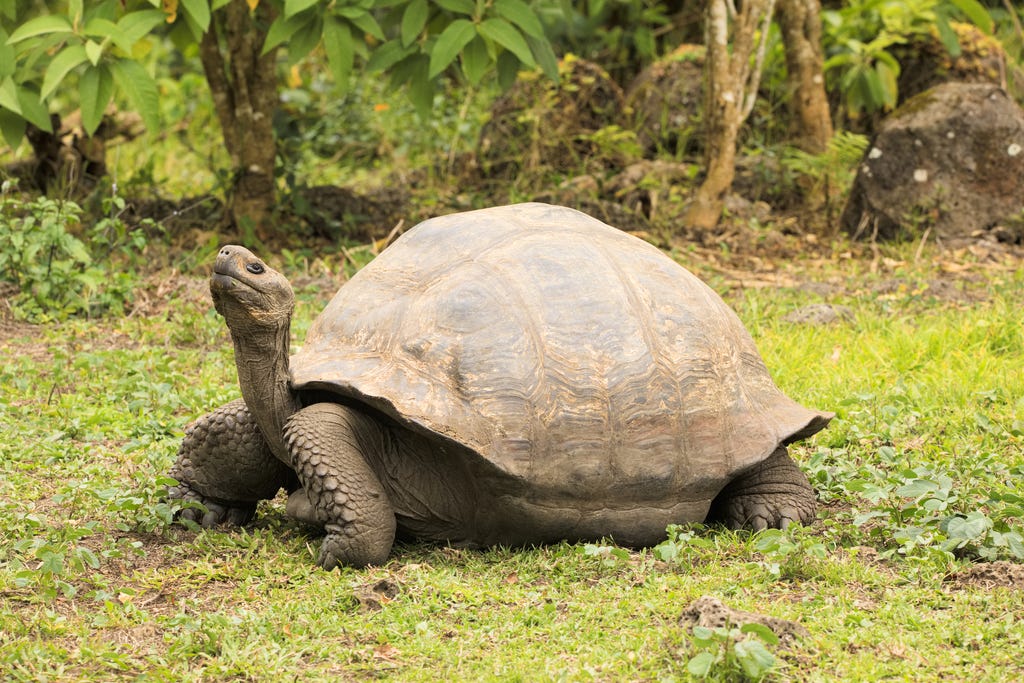Tales of perseverance
How 20,000 tadpoles, 500 tortoises and a turtle named #9 made it to the finish line
I’ve collected a few stories of surprising perseverance this week. The first begins in 2015, when a good Samaritan found a female Western pond turtle who’d been run over by a car. The rescuer took the turtle to a wildlife hospital. Turns out, she was carrying a clutch of 19 eggs, which they incubated, named #1 through #19, hand raised, and then released to the wild. The hatchlings’ luck continued when their new home is a beach lagoon that was the starting point for a $16 million restoration project spanning 20 years. Read on to find out what happens.
In this issue:
trekking turtles
high-altitude toads
bison-like tortoises
Sri Lankan sea turtle saviors
Turtles swim five miles upstream over six years to reach newly restored creek in the redwoods
Western pond turtles are swimming at Muir Woods National Monument, a majestic and heavily-visited old-growth redwood grove north of San Francisco, the first time they’ve been spotted in the park in 30 years.
Their arrival came as a surprise to national park staff, who were almost done with a creek restoration to welcome back salmon. Downstream, near Muir Beach, the creek was freed from a levee, a parking lot and a bridge and reconnected to its former floodplain. Upstream, restoration crews moved a trail away from the water’s edge, re-meandered Redwood Creek and placed large fallen logs1 to stabilize banks, slow water and create shady, protected pools where young fish can thrive.
That’s where park volunteers spotted a lone male sunning himself on a logjam in July of 2023.2
“Is that one of the pond turtles we planted at the lagoon down the hill six years ago?” they wondered.
Yes, he is.
His name is Turtle # 9 and he was among the clutch of nineteen eggs rescued in 2015. In 2017, conservationists released the batch at the Muir Beach lagoon five miles from Muir Woods. By 2021, conservationists had released 42 juvenile, captive-bred pond turtles at the lagoon. By summer 2023, two males had migrated up the entire creek, an elevation gain of 545 feet.
Turtle #9, our sunning superstar, was found deep in Muir Woods on a large log placed by restoration crews. If you think of #9 moving one inch at a time, that’s 317,000 footsteps. All while braving the jaws of raptors, weasels, ravens, invasive bullfrogs and fish. Since then, several turtles have been spotted, including females of breeding age.
From Bay Nature magazine:
The reintroduction had followed the NPS’s restoration at Muir Beach from 2009 to 2013 that brought back wetlands and the channel, planted native species like willows, and created areas of slow-moving water that turtles and juvenile fish like.
Thus, Turtle #9 went from an egg that narrowly survived death by car, to shuffling five miles upstream over many years, to escaping all the heavy machinery used in the final restoration, to basking in the mottled light of old-growth redwoods among prospective mates. With a lifespan of 50 years, I know he’ll sire many grandchildren in this valley of towering and still giants.
Over 100 years ago, an estimated 63,000 Western pond turtles were hunted for use in soups in booming San Francisco, a habit that has luckily subsided. Now, they’re being crowded out in much of their habitat by the larger, more aggressive and non-native red-eared slider turtles from America’s Midwest and South, a popular exotic pet store item.
Western pond turtles only inhabit the Western coast of the United States and are endangered in Washington. They are listed as a “species of special concern” in California and Oregon. Some populations have declined 80 percent. They aren’t known to wander as much as Turtle #9 and his compatriots, usually staying within a half mile of their home pond.

From the National Park Service on the need for restoration:
For the past 100 years, agriculture, logging, trails and roads-building increased erosion and degraded the creek and floodplain system at the creek mouth. Flooding in low-lying areas occurred frequently. In addition, endangered coho salmon and threatened steelhead trout were exposed to predators and the elements and had few places to shelter, transform, and bulk up for their oceanic journey.
Turtles aren’t the only sign the restoration worked. King (chinook) salmon recently returned to Redwood Creek, the first time they were ever recorded there. Coho salmon spawned strong there in 2023. (Remember, salmon bring nutrients and carbon from the ocean to the land, where they fertilize trees and shrubs with their decomposing bodies.) Steelhead and cutthroat trout call the creek home, as well as California giant salamanders.
Why care about turtles? Turtles help engineer healthy ecosystems. They’re an important part of food webs, being both prey and predator. Turtles also disperse seeds throughout their habitat. Their longevity holds secrets science is still trying to unlock. And, cultural references throughout time look to turtles to remind us that, sometimes, reaching our goals takes a whole lot of patience.

Colorado toads make tadpoles, as they should
Tadpoles of endangered boreal toads are swimming around in a Colorado bog seven years after biologists first released adults and tadpoles in an effort to save the species. The toads are threatened due to a skin fungus that is killing amphibians worldwide.
These amphibians were once so abundant they ate bugs off of lampposts in the nearby town of Pitkin. Colorado’s only alpine toad, they grow to 4.5 inches (11.5 centimeters) Even when they are toadlets only half an inch long, they hibernate for six to eight months of the year while buried under several feet of snow.
The bog sits at 11,200 feet (3,413 meters) of elevation. Over seven years, biologists trekked by foot, bringing 1,200 toads and 20,000 tadpoles to release at the bog. The toads are proofed in antifungal wash before making the journey. Once six years old, they’re mature enough to breed.
“It’s a really big deal,” biologist Daniel Cammack said in a Colorado Parks and Wildlife news release after discovering the wild tadpoles. “This day is a culmination of a lot of dedicated people’s efforts, including multiple biologists, technicians and hatchery personnel. Everyone who has been involved in this project has poured their heart and soul into it. That's what it takes to get here.”
The boreal toad is listed as endangered in Colorado and New Mexico and is protected in Wyoming, where biologists are studying populations of disease-resistant toads. They are found in Canada and as far north as Alaska as well.
Giant tortoises help albatross land in the Galapagos
Albatross are famously graceful flyers and infamously clumsy landers. When conservationists at the Galapagos Conservancy released 500 tortoises of several species across the Galapagos Islands in 2023, they found that the giants cleared so much space that albatross landed 49 more times in the same area than before the tortoises were released. Tortoises are essentially landing strip engineers.
From Good News Network:
Because the tortoises are the largest herbivores in the ecosystem, they perform the same acts as bison do in North America and Europe, and elephants in Africa —clear space.
The waved albatross is the largest bird of the Galapagos, with a wingspan of eight feet (2.5 meters). They are critically endangered and only breed on Española Island. Their giant tortoise friends are also endangered, having been hunted to near extinction by the 1800s.
Must-see, 30-second footage of an albatross landing:
Giant tortoises were the sailors’ food that fueled the exploration and exploitation of the Pacific. Slow-moving, they were an easy catch for pirates, whalers, fur traders and scientists who frequented the islands from the 1600s through the 1800s. They also stayed alive on ships without needing to be fed. Historians believe 100,000 giant tortoises were collected during this time, leaving four species of tortoises extinct on several islands. Eventually, goats, rats and tourists were among the 1,400 introduced species of plants and animals that pummeled the Galapagos Islands’ ecosystems.
If you were a giant tortoise on Española Island in the 20th Century, you were a centenarian, still middle-aged for a tortoise, and your only company was 14 others just like you. For your entire life, your offspring were eaten by rats and your food supply eaten by goats. Luckily, some biologists found you in the 1960s and realized why none of you were under 100 years old. They took you into a captive breeding program, where you happily mated and multiplied.
Goats were removed from Española in 1978. Rats have been eliminated on several islands.
Giant tortoises now number over 3,000 now on Española, thanks to captive breeding. In 2020, that program closed and the original 15 breeding adults were released back into the wild.3 4
“Nature is slow, but sure; she works no faster than need be; she is the tortoise that wins the race by her perseverance.
— Henry David Thoreau
Not enough turtle news for you?
Here’s one more, from The Guardian: Volunteers help protect baby sea turtles in Sri Lanka
Aware that life for the turtles was becoming more difficult, Muditha Katuwawala expanded the activities of the Pearl Protectors, which he coordinates, to include regular patrols. Working with the coastguard, the volunteers help to find eggs laid in risky areas and remove them to a safe nesting place on the beach until they hatch.
These efforts will surely pay off, but it will take a generation.5 Sea turtles don’t mature for 25 to 30 years. Florida started protecting sea turtles about 30 years ago, and these efforts are finally showing progress, with hundreds of thousands of nests counted last year. For instance, volunteers counted 13,000 green sea turtle nests at one Florida refuge in 2023, whereas in the early 1980s, those numbers might have totaled only five or 10 at the same refuge.6 This year is looking optimistic: Sea turtles are packing Southwest Florida beaches with nests.
Go climb those conservation mountains
Earth Hope is a call to action. Progress doesn’t happen overnight. Feeling despair? Don’t give up. Get involved. Behind each of the successes above are legions of incredibly passionate and hard-working humans, biologists trekking tadpoles to high altitude, park staff in the trenches of restored streams, conservationists watching every tortoise hatch and grow, and volunteers patrolling beaches all night.
Join millions of us by claiming a square of this planet. Volunteer, get involved, restore what you’ve got, give to great causes and advocate for policies to save this Earth.
We’ve got some steep mountains to climb. Slow and steady wins the race.
Recent headlines from Earth Hope
Five more condors fly over Northern California, thanks to a persistent tribe
Tahoe’s sandhill cranes show wetland restoration is working
How paying farmers saved half a million tricolored blackbird chicks
About Earth Hope:
Earth Hope is a solutions-based journalism project that highlights environmental success stories from around the globe, because hope is the foundation of progress. Consuming bad news is important, but we should also remind ourselves frequently that progress happens every day.
About me:
I’m Amanda Royal, a former newspaper reporter who covered wildfires, invasive species, water quality, wildlife and other environmental topics in California and Nevada (while writing under my maiden name and byline Amanda Fehd). The pseudonym “Earth” was a bit accidental. It grew on me quickly, so I thought I’d keep it for a while. I’m new to Substack as of late July 2024. Thanks for the wonderful reception!
Our centuries-old habit of removing large wood from rivers and creeks is damaging to riparian ecosystems, including turtles who need places to sun. This article from Penn State Extension sums it up well: Benefits of Large Woody Debris in Streams.
The park service did not publicize Turtle #9 until this July because they were waiting for confirmation he’d escaped the heavy equipment.
Who knows how old they are now. Galapagos tortoises can live up to 180 years!
The Española species is still being bred by the Galapagos Conservancy, which released 86 juveniles last year to Española. These were among the 500 total the conservancy released into the wild.
That’s exponential growth!











The story of Turtle #9 especially resonated with me. His journey upstream, overcoming obstacles for years, is such a powerful reminder that great things can take time and determination.
It made me think of a quote I recently heard: Slow and steady wins the race.
This is so true, not just for turtles but for all of us in life!
It's great to read all these stories, especially turtles in Muir Woods! I loved Muir Woods when I visited as a child, many years ago now. Thanks for the mention too, I'm glad you found the Guardian article worth linking to!